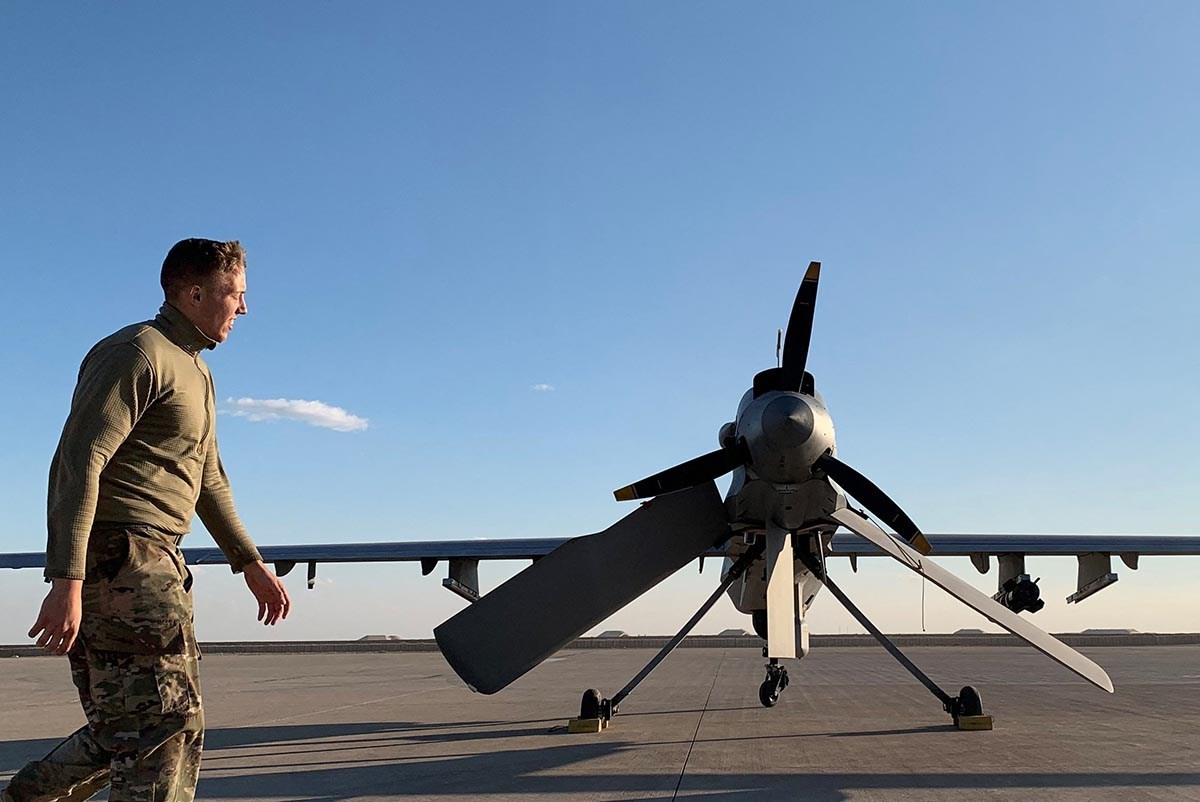[ad_1]
At least 10 Katyusha-type rockets slammed into the Ain al-Asad airbase located in Anbar province in Western Iraq on the morning of March 3. Since the earlier attack in January 2020 by heavier Qiam-2 advanced tactical ballistic missiles launched from Iran, the airbase has been reinforced with air defenses that proved unable to stop the rocket attack. Can the US protect its personnel in Iraq or elsewhere from rocket attacks?
The latest available information says that one US contractor was killed and one US service member wounded. Five contractors also were wounded.
Unlike the January attack, this assault originated not far from the airbase in the al-Bayader agricultural area near the town of al-Baghdadi. The rockets were launched from a hidden set of launch tubes on a standard dump truck. The truck was found burned out  8 km (5 miles) from the al-Asad airbase.
The rockets were 122 mm Arash variations made in Iran. (The rockets are named after Arash the Archer, a heroic archer in Persian mythology.) Arash rockets have an 18 kg (about 40 lbs) high explosive warhead. Typical Arash models are not guided but depend on launch angle and are fin-stabilized. However, Iran announced in 2020 it was introducing a guided version. There is no definitive information that the Arash rockets used against al-Asad were guided but there is physical evidence found at the scene of the burned-out truck that indicates the launch group had an internet connection. Â
It is notable that the rockets hit their mark, suggesting something more was involved than an unguided round. Very often Katyusha-type rockets miss their targets by a significant margin. This suggests that the rockets used to attack the Ain al-Asad base on March 3 may have been equipped with inertial guidance systems, GPS and internet links for control and guidance.
The launch tubes in the dump truck were cleverly hidden under the truck bed. By raising the bed, the truck became a TEL (a transporter, erector, launcher). There is a video of the burning truck in which the launch tubes under the bed are visible.
It is not clear why the truck burned. It could have caught fire when the multiple rocket launches ignited the fuel tank and triggered an explosion. Or the launch team may have set fire to it after the launch disabled the vehicle.
The US is supposed to have two air defense systems at Ain al-Asad: a Patriot missile battery and a C-RAM. There is no information that either system was activated. Even if the C-RAM and Patriot systems did respond to the Katyushas, neither is ideally configured to counter this kind of threat. C-RAM is a gun system and the operator has to detect, aim and fire the gun to hit an incoming missile. Ten rockets arriving in quick succession would most likely overwhelm a C-RAM system even if it had detected the incoming rockets in time. The Patriot system is not designed to hit small artillery-round type rockets. It would seem there is a coverage gap for US forward defenses that was exploited by the enemy. Â
The Arash is reported to have a speed of 1,610 mph, or Mach 2. Given the distance covered, this works out to an 11-second flight trajectory from launch to target.
Unfortunately in this attack, there was no early warning. When Ain al-Asad was attacked by Qiam-2 missiles in January 2020 there was a warning. The US knew the Iranians had accessed commercial satellites to pinpoint target locations on the base. It is also quite possible that preparation for the launch of the liquid-fueled Qiam-2 rockets was seen by spy satellites, although this has not been reported. Prior warning allowed time for personnel to enter hardened shelters and for vital equipment to be removed from the base.
The lack of an effective air defense system combined with the elusiveness of the enemy suggests that the US cannot passively defend its forward-based forces in places such as Iraq or Syria. There are three alternative defense possibilities: 1) Pull US troops out of indefensible bases; 2) develop air defenses that can handle all threats; 3) attack the source of the missiles.
In regard to removing US troops from these bases, sentiment is growing in Washington that this could be the only viable near-term solution. Think tanks like Rand and organizations such as the Atlantic Council have been drawing up plans to facilitate a US pull out from Iraq. Removing US troops does not preclude the third option of going after the sources of the threat. In current conditions US forces and US contractor personnel are no more than hostages to the enemy.
The US Army is working on an integrated air defense system; however most of the focus is on drones and cruise missiles. These are much slower flying threats than Katyusha rockets and fly over considerably longer distances, allowing a good response time once detected. But even if a comprehensive solution is developed, fielding it is five to ten years in the future, leaving forces in Iraq and elsewhere unprotected in the interim.
The third option, going after the source of the attack, as US President Joe Biden did after a US contractor was killed and eight others wounded in Erbil on February 15, also by Katyusha type rockets, does not assure that it will stop subsequent attacks, as the attack on Ain al-Asad airbase clearly shows. The reason for this is that the militias who launch the rockets, some with new names to avoid definitive identification, but most regarded as pro-Iran militias, are taking their orders from either Tehran or from the Iranian Islamic Revolutionary Guard Corps. Hitting the militias did not stop the rocketing of Ain al-Asad.
The US has not responded to Iranian-sponsored attacks by striking Iran, and neither has Saudi Arabia, which has suffered attacks from Iranian proxies in Yemen and with direct attacks from Iran in the case of the Khurais and Abqaiq oil installations in September 2019. On February 27 of this year, a combined ballistic missile and drone attack on the Saudi Capital of Riyadh took place where both the drones and missiles have been attributed to the Houthis in Yemen, Iranian proxies, but may also have been launched from either Iran or nearby northern Iraq. Yemen is far from Riyadh and the type of missile and drones used are different from those known to be in the hands of the Houthis. For example, the drone remains found after the attack appear similar if not identical to the drones used in the Abqaiq attack. The drone attack was aimed at the Saudi Royal Palace.
Fortunately, in the attacks on February 27, Saudi air defenses, particularly the Patriot GEM-T interceptors destroyed the incoming ballistic missiles.
Both the US and Saudi Arabia do not want a war with Iran, affording Iran the unique luxury of killing US troops and contractors and destroying infrastructure in both countries. And, while the US can pull its troops out of Iraq, Saudi Arabia has no such option.
In the meantime, protecting US bases abroad will remain challenging, perhaps impossible.
[ad_2]
Source link














